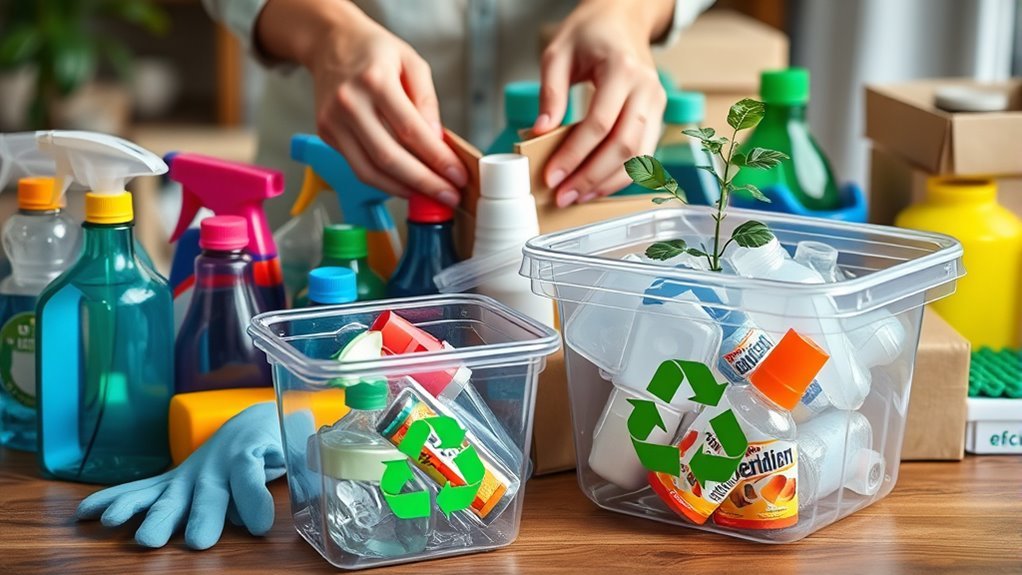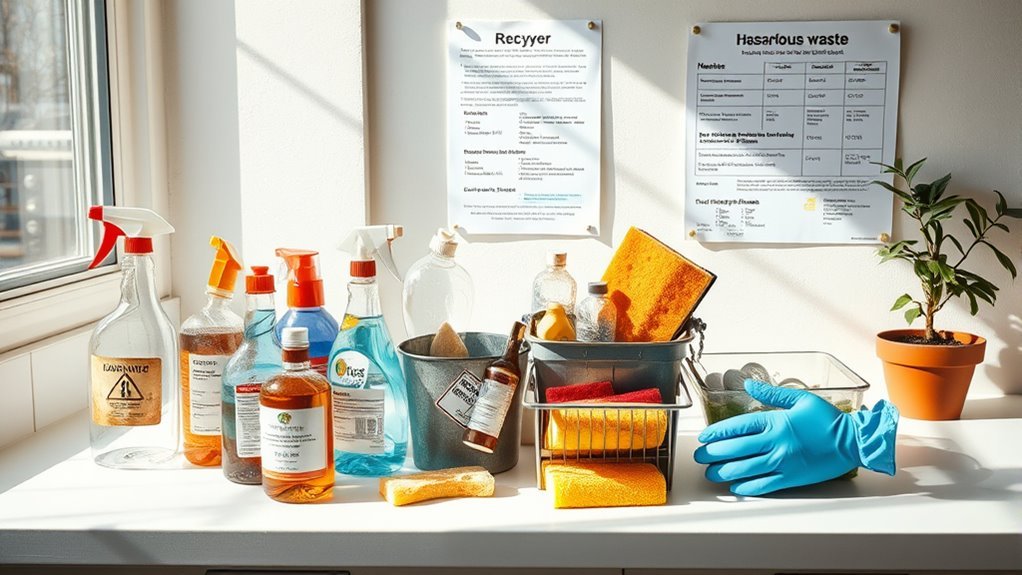How to Clean and Recycle Old Cleaning Supplies
You can clean and recycle old cleaning supplies by first identifying which containers are recyclable—usually plastic, glass, or metal—and checking your local guidelines. Make sure to empty them completely, rinse well to remove residue, and remove labels if possible. Hazardous products need special disposal at designated sites, so never pour them down drains. Repurposing old bottles and tools is another great option. If you want to reduce waste and make smarter buying choices, there’s a lot more you can do.
Identifying Which Cleaning Supplies Can Be Recycled

Knowing which cleaning supplies can be recycled is the first step toward reducing waste. You don’t have to feel trapped by traditional products that harm the planet. Look for eco friendly alternatives labeled as recyclable or biodegradable products to make smarter choices. Many plastic bottles and containers used for cleaners can be recycled, but you’ll want to check your local guidelines to see exactly what’s accepted. Avoid tossing items with hazardous residues, as these can’t be processed easily. By choosing biodegradable products in the future, you’re embracing freedom from pollution and waste buildup. Identifying recyclable supplies empowers you to take control, reduce your environmental footprint, and support a cleaner, greener lifestyle without unnecessary restrictions.
How to Safely Empty and Rinse Cleaning Containers
Before recycling your cleaning containers, it’s important to empty and rinse them properly to prevent contamination. Start by using up all the product inside or transferring any leftover liquid to a safe, labeled container for future use or safe disposal. Once empty, use rinsing techniques like filling the container halfway with warm water, shaking it gently, and pouring the rinse water down a drain connected to a sanitary sewer—not storm drains. Repeat this process until the container is clean. This simple step guarantees containers are free of residue, making recycling more effective and helping you practice safe disposal. By following these steps, you maintain your freedom to recycle responsibly, keeping your environment clean and safe for everyone.
Proper Disposal Methods for Hazardous Cleaning Products

Although it might seem easier to toss hazardous cleaning products in the trash, you’ll need to follow specific disposal methods to protect yourself and the environment. Handling hazardous waste requires care to guarantee safe disposal without causing harm.
Here’s how you can do it right:
- Identify hazardous waste by checking labels for warnings and ingredients.
- Never mix hazardous products; keep them in their original containers with labels intact.
- Use local hazardous waste collection sites or special community disposal events—they’re designed for safe disposal.
- If unsure, contact your local waste management authority for guidance on proper handling.
Tips for Removing Labels and Residue From Bottles
Wondering how to get stubborn labels and sticky residue off your cleaning bottles? You’re not alone. Effective label removal starts with soaking the bottle in warm, soapy water for 10-15 minutes. This loosens the label and makes peeling easier. For leftover adhesive residue, rub it gently with a cloth soaked in rubbing alcohol, vinegar, or cooking oil. These common household items break down the sticky film without harsh chemicals. If residue persists, a plastic scraper can help without damaging the bottle. Patience is key—avoid scratching or tearing the surface. By mastering these simple tricks, you free your bottles from unwanted labels and adhesive residue, readying them for reuse or recycling. This small effort gives you freedom from waste and clutter alike.
Recycling Plastic, Glass, and Metal Cleaning Containers

When you’re ready to recycle your cleaning containers, start by sorting them into plastic, glass, and metal groups. Make certain to remove any leftover residue and labels to avoid contamination. Finally, check your local recycling guidelines to guarantee you’re disposing of each material correctly.
Sorting Containers by Material
Before recycling your cleaning containers, you’ll need to sort them by material—plastic, glass, or metal—since each type requires different processing. Understanding container materials and sorting techniques is key to making your recycling efforts effective and hassle-free. Here’s how you can do it:
- Identify the Material: Check the bottom or label for recycling symbols indicating plastic, glass, or metal.
- Separate Containers: Keep plastics, glass bottles, and metal cans in distinct piles to avoid contamination.
- Avoid Mixing: Don’t combine materials, as recycling centers process each type separately.
- Check Local Guidelines: Some areas accept specific container materials differently, so follow local sorting rules.
Removing Residue and Labels
Once you’ve sorted your containers by material, the next step is to remove any leftover residue and labels. Start by rinsing out any remaining cleaning solution—this clears the way for effective label removal. For stubborn adhesive, grab an adhesive solvent; it’s your best ally for dissolving sticky residue without extra scrubbing. Peel off paper labels carefully; soaking containers in warm, soapy water helps loosen them. If the adhesive persists, apply the solvent sparingly and wipe clean. This not only preps your containers for recycling but also frees you from contamination concerns. Taking these simple steps guarantees plastic, glass, and metal containers are ready to be recycled responsibly, giving you the freedom to contribute to a cleaner environment without hassle.
Proper Local Recycling Guidelines
Although recycling rules can vary widely by location, you’ll want to check your local guidelines to confirm plastic, glass, and metal cleaning containers are sorted and processed correctly. Following local regulations not only protects the environment but also guarantees your efforts count.
Here’s how to stay on track:
- Use official recycling resources to find what materials your area accepts.
- Rinse containers thoroughly to remove any chemical residues.
- Remove caps and lids if your local program requires it, as they might be recycled separately.
- Flatten plastic containers when possible to save space and improve collection efficiency.
Creative Ways to Repurpose Old Cleaning Bottles and Tools
You can give old spray bottles a new life by turning them into plant misters or homemade air freshener containers. Don’t toss out worn cleaning tools just yet—many can be repurposed for scrubbing tough spots or as garden tools. With a bit of creativity, your used supplies can stay useful and reduce waste.
Upcycling Spray Bottles
If you’ve got old spray bottles lying around, don’t toss them just yet—they can be transformed into handy tools for various tasks. Upcycling spray bottles gives you freedom to get creative and reduce waste. Here are some ideas to get you started:
- Use them as DIY spray refills for homemade cleaners or plant misters.
- Turn bottles into upcycled planters by cutting them in half and adding soil for small herbs.
- Create a paint sprayer by filling with diluted paint for quick touch-ups or crafts.
- Make a watering can by poking holes in the nozzle for gentle irrigation of delicate plants.
With these simple hacks, you’ll keep your space green and resourceful without buying new stuff.
Reusing Cleaning Tools
Three simple cleaning tools you probably have lying around can find new life with a bit of creativity. By applying smart reuse strategies, you can transform old brushes, spray bottles, and cloths into practical, eco friendly alternatives for everyday tasks. This not only cuts waste but also fuels your freedom to live sustainably without hassle.
| Tool | Repurposing Idea |
|---|---|
| Old Spray Bottles | Plant misters or homemade cleaners |
| Scrub Brushes | Shoe cleaners or grout scrubbing |
| Microfiber Cloths | Dusting rags or car detailing |
| Empty Jars | Storage for small items or DIY candles |
With these ideas, you’re not just recycling—you’re embracing a lifestyle that respects the planet and your independence.
Where to Find Local Recycling Centers for Cleaning Supplies
Wondering where to take your used cleaning supplies for proper recycling? Finding the right spot is easier than you think. Start by tapping into your community recycling programs—they often accept hazardous materials like cleaning products. Here’s how to locate local resources:
- Check your city or county’s official website for hazardous waste collection events.
- Visit Earth911.com and enter your zip code to find nearby recycling centers.
- Contact local waste management services for guidance on accepted items.
- Ask at hardware stores; some offer take-back programs for cleaning supplies.
Preventing Waste: Buying and Using Cleaning Products Responsibly
Although cleaning supplies are essential, you can reduce waste considerably by choosing and using them wisely. Opt for eco friendly alternatives that minimize environmental impact while delivering the results you want. Look for concentrated formulas or refillable packaging to cut down on single-use plastics. Sustainable purchasing means buying only what you truly need, avoiding overstock that often ends up unused and discarded. When you use products efficiently, you extend their life and reduce the frequency of replacements. Embrace bulk buying or local brands with responsible packaging to support greener choices. By taking control of your cleaning supply habits, you not only free yourself from excess clutter but also contribute to a cleaner planet. Your mindful decisions make a real difference in preventing waste.
Häufig gestellte Fragen
Can Expired Cleaning Supplies Still Be Safely Used for Cleaning?
You might wonder about expired product safety when using old cleaners. While some expired supplies can still work, it’s smart to do a cleaning efficacy evaluation before relying on them. Their effectiveness often decreases over time, and using them might not give you the results you expect. If you want to keep your space clean without risking poor performance or safety issues, testing or replacing expired products is the way to go.
How to Neutralize Strong Chemical Odors From Old Cleaning Products?
Imagine walking into a room refreshed, not overwhelmed by chemical odor. You can achieve that by using neutralizing techniques like placing bowls of white vinegar or baking soda nearby—they absorb and neutralize harsh smells naturally. Ventilation helps too, so open windows or use fans to let fresh air flow freely. These simple steps guarantee you don’t feel trapped by strong chemical odors, giving you the freedom to enjoy a cleaner, fresher space.
Are Homemade Cleaning Solutions as Effective as Commercial Ones?
When you compare homemade cleaning solutions to commercial ones, you’ll notice the effectiveness comparison depends a lot on ingredient analysis. Homemade cleaners usually use simple, natural ingredients like vinegar or baking soda, which can be great for light tasks. Commercial products often contain stronger chemicals designed for tougher grime. So, while homemade options offer freedom from harsh chemicals and save money, they might not always match the power of store-bought cleaners for heavy-duty jobs.
What Are Eco-Friendly Alternatives to Conventional Cleaning Supplies?
You’d swear plant-based cleaners could conquer the world with their power! When you want eco-friendly alternatives, look for natural disinfectants like vinegar, baking soda, or tea tree oil. They’re gentle on the planet and tough on grime. Choosing these frees you from harsh chemicals, letting your home breathe easy while you enjoy a cleaner, greener lifestyle. You don’t have to sacrifice effectiveness for sustainability—you can have both!
How Long Do Different Cleaning Products Typically Last Unopened?
You’ll find that the cleaning product shelf life varies—unopened cleaning supplies like liquid detergents usually last about a year or two, while powdered ones can last longer, up to three years. Disinfectants often have a shelf life of around one year. Knowing this helps you avoid expired products and frees you from doubts about their effectiveness. Always check the label, so you’re confident in what you’re using.






